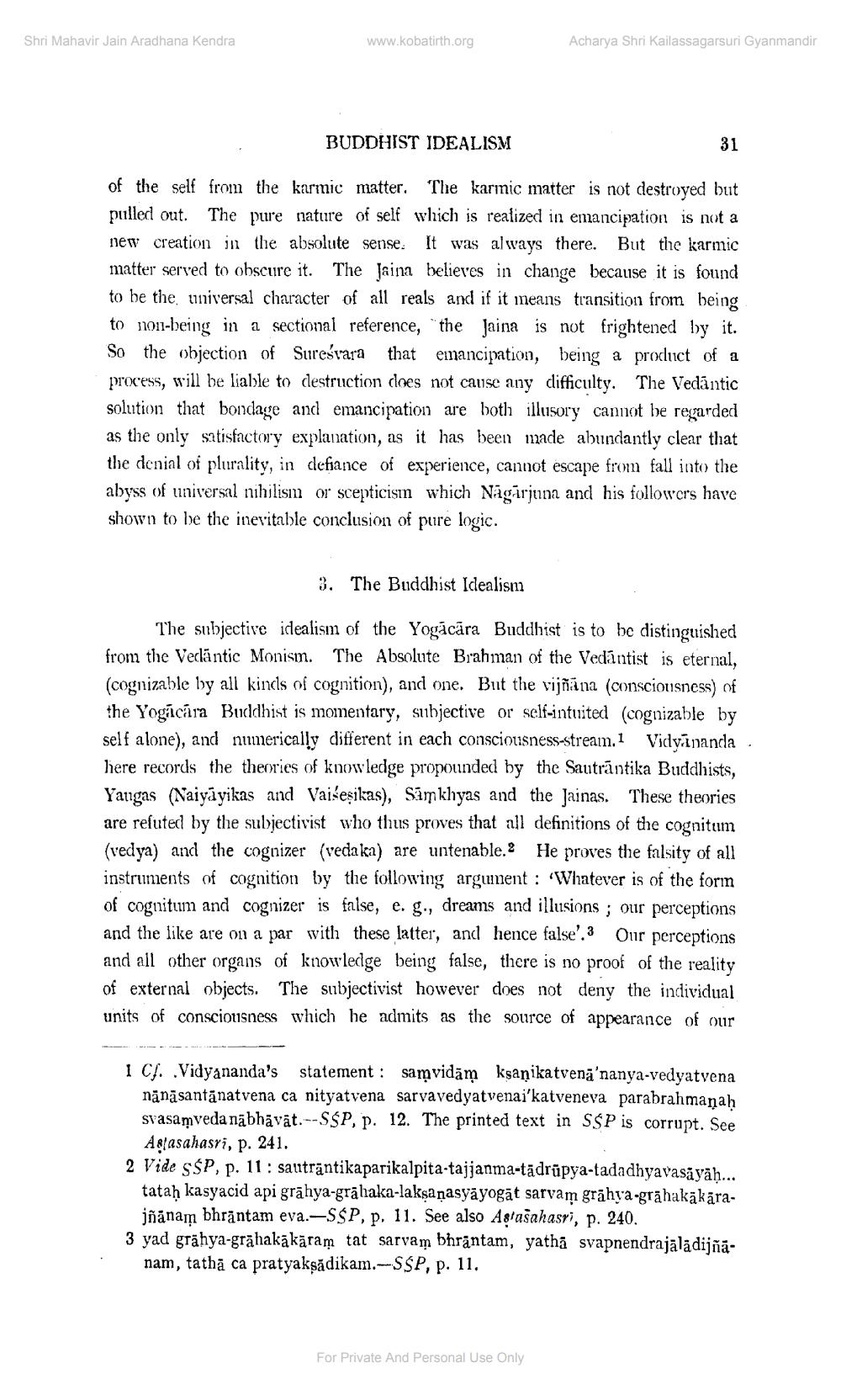________________
Shri Mahavir Jain Aradhana Kendra
www.kobatirth.org
Acharya Shri Kailassagarsuri Gyanmandir
BUDDHIST IDEALISM
31
of the self from the karmic matter. The karmic matter is not destroyed but pulled out. The pure nature of self which is realized in emancipation is not a new creation in the absolute sense. It was always there. But the karmic matter served to obscure it. The Jaina believes in change because it is found to be the universal character of all reals and if it means transition from being to non-being in a sectional reference, the Jaina is not frightened by it. So the objection of Sureśvara that emancipation, being a product of a process, will be liable to destruction does not cause any difficulty. The Vedāntic solution that bondage and emancipation are both illusory cannot be regarded as the only satisfactory explanation, as it has been made abundantly clear that the denial of plurality, in defiance of experience, cannot escape from fall into the abyss of universal nihilism or scepticisin which Nagarjuna and his followers have shown to be the inevitable conclusion of pure logic.
3.
The Buddhist Idealism
The subjective idealism of the Yogācāra Buddhist is to be distinguished from the Vedāntic Monism. The Absolute Brahman of the Vedāntist is eternal, (cognizable by all kinds of cognition), and one. But the vijñāna (consciousness) of the Yogācāra Buddhist is momentary, subjective or self-intuited (cognizable by self alone), and ninerically different in each consciousness-stream.1 Vidyananda here records the theories of knowledge propounded by the Sautrāntika Buddhists, Yangas (Naiyāyikas and Vaiseşikas), Samkhyas and the Jainas. These theories are refuted by the subjectivist who thus proves that all definitions of the cognitum (vedya) and the cognizer (veda ka) are untenable. He proves the falsity of all instruments of cognition by the following argument : 'Whatever is of the forin of cognitum and cognizer is false, e. g., dreams and illusions ; our perceptions and the like are on a par with these latter, and hence false'.3 Our perceptions and all other organs of knowledge being false, there is no proof of the reality of external objects. The subjectivist however does not deny the individual units of consciousness which he admits as the source of appearance of our
1 CJ. Vidyananda's statement : samvidām ksaņikatvena'nanya-vedyatvena
nānāsantānatvena ca nityatvena sarvavedyatvenai’katveneva parabrahmanah svasamveda nābhāvāt.--SŚP, p. 12. The printed text in SŚP is corrupt. See
Aglasahasri, p. 241. 2 Vide SŚP, p. 11: sauträntikaparikalpita-tajjanma-tādrūpya-tadadhyavasayah... tatah kasyacid api grāhya-grāhaka-lakṣaṇasyayogāt saryam grāhya-grähakākāra
iñānam bhrāntam eva.-SSP, p. 11. See also Asiasahasri, p. 240. 3 yad grähya-grāhakākāram tat sarvam bhräntam, yathā svapnendrajālādijñā
nam, tathā ca pratyaksădikam.-SSP, p. 11.
For Private And Personal Use Only




